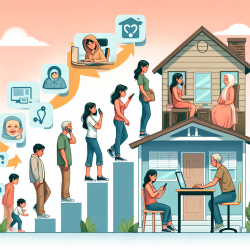Empowering Change: Harnessing Housing Mobility to Break the Cycle of Teen Parenting
As practitioners dedicated to improving children's outcomes, understanding the social determinants that influence health and behavior is crucial. The study "A Housing Mobility Program's Impacts on Teen and Young Adult Parenting" sheds light on how housing mobility can play a pivotal role in reducing intergenerational teen births, offering insights that can inform and enhance your practice.
Understanding the Impact of Housing Mobility
The Moving to Opportunity for Fair Housing Demonstration Program (MTO), implemented in 1994, aimed to assess the effects of relocating families from high-poverty to low-poverty neighborhoods. The study focused on young adults and youth who were part of this program, examining the impact on teen births.
While the overall effect on teen births was not significant, the study revealed a noteworthy reduction in intergenerational teen births among young adults whose parents were teen parents. Specifically, the proportion of young adults having a teen birth was 21% lower among those offered housing vouchers to low-poverty neighborhoods.
Implications for Practitioners
For practitioners, these findings highlight the importance of considering environmental and social factors in interventions aimed at reducing teen births. Here are some actionable insights:
- Focus on Comprehensive Programs: Programs addressing multiple social determinants, such as housing, education, and health, are vital. Consider integrating these elements into your practice to create holistic interventions.
- Promote Safe and Supportive Environments: Encourage families to seek environments that offer better educational and economic opportunities, which can significantly impact children's futures.
- Encourage Parent-Child Communication: Foster open communication between parents and children about decision-making and behaviors, which is critical for positive sexual health outcomes.
Encouraging Further Research
The study opens avenues for further exploration into how housing mobility and related factors can reduce teen births. Practitioners are encouraged to delve deeper into these topics to enhance their understanding and improve their practice. Consider exploring questions such as:
- How do specific neighborhood characteristics influence teen birth rates?
- What role does parental involvement play in mitigating the risk of teen pregnancies?
- How can we better integrate housing mobility insights into existing intervention programs?
Conclusion
Reducing intergenerational teen births requires a multifaceted approach that addresses the broader social determinants of health. By leveraging insights from housing mobility programs like MTO, practitioners can develop more effective strategies to support children and families in achieving better outcomes.
To read the original research paper, please follow this link: A housing mobility program's impacts on teen and young adult parenting.










